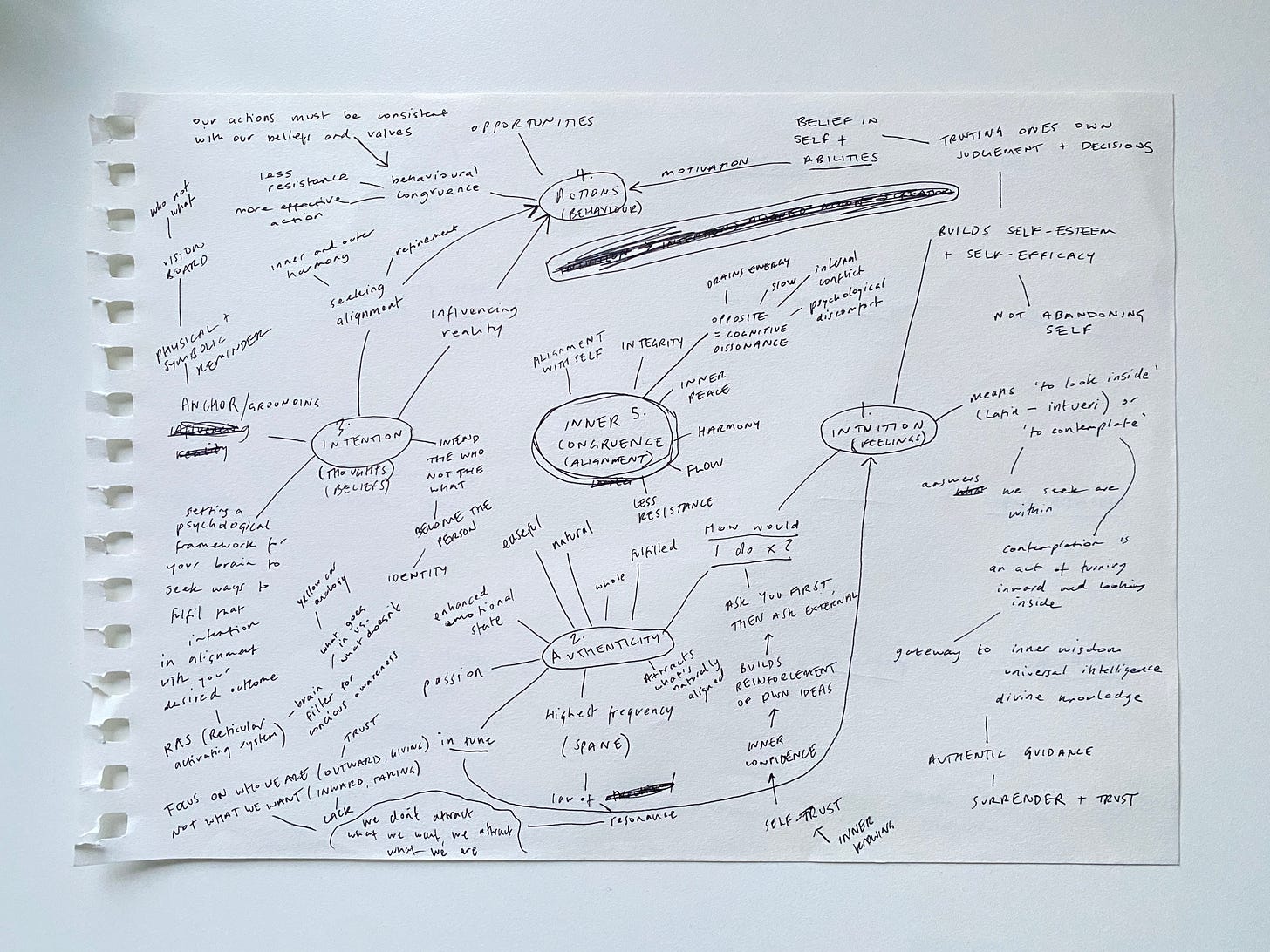Your inner guidance is your most reliable strategy
How to achieve your goals by connecting to your intuition
Hello and welcome to The Monday Memo.
Every Monday, I’ll be sharing practical ways to free up your time, design your life and succeed doing work that matters to you.
The Monday Memo
TO: Those who want to connect with the wisdom within.
FROM: Natalia
DATE: 16th June 2025
SUBJECT: Your inner guidance is your most reliable strategy.
Inner congruence.
— The alignment between one’s internal thoughts, feelings and values, and their outward actions and behaviours.
You could also describe inner congruence as connecting your head with your heart or as living authentically.
When you live authentically, you experience a sense of harmony, peace and fulfilment.
Sounds great, right?
But how do you actually do it?
This is the exact question I asked myself which led to what I’m about to share with you.
I’m going to distil the below mind-map into a repeatable cycle so that you can develop your inner congruence and create a more authentic business and life.
Remove the noise so you can hear your own voice
Running an online business is an ongoing process of balancing what you consume with what you create.
You have to be active on whatever social media platforms you choose and engage with people there. Naturally this means you’re absorbing the thoughts and opinions of others.
You also have to continually learn new things — which also means absorbing the thoughts and opinions of others.
Unless you've developed a deeply reflective and internally grounded mindset, much of your thinking is likely influenced—often unconsciously—by others.
This isn’t necessarily a problem…
Until it comes to trying to move your own life in the direction you want.
Without a mindful practice, it can be all too easy to follow someone else’s path, thinking it’s your own.
This is where the micro cycle comes in.
Part 1: The Micro Cycle
The micro cycle is a 7-step process that takes you from introspection all the way through to integration.
Think of it as an expanded version of:
Thinking → Doing → Being
The micro cycle is designed to connect you with your intuition so that you can actualise your authentic desires.
(1) Introspection
This step is the practice of looking inward to connect with your desires, needs and goals. It’s about gaining clarity on what you want to actualise.
The best way to practice introspection is through journalling.
Journalling Practice
You can journal your answers to the following questions:
What specific goal do I want to actualise?
Why does this goal matter to me on a personal level?
How would actualising this goal impact my life and well-being?
What feelings arise when I think about achieving this goal?
In what way does this goal align with my values or purpose?
(2) Intuition
This step is about connecting with your inner guidance to explore how you might actualise your vision or goals and trusting that wisdom to influence your direction.
Rather than seeking external advice or solutions right away, this step invites you to consult your internal guidance system for answers and provides powerful validation as to whether the direction you want to take is truly aligned to you.
The best way to connect to your intuition is through meditation. I recommend either listening to meditative music or sitting in silence.
Meditation Practice
Find a quiet space and sit comfortably in silence or with calming natural sounds.
Focus on your breath until you feel centred.
Once still, bring to mind what you want to actualise and ask yourself:
Does this goal feel right for me?
How would I approach this goal if I couldn’t research how other people would approach it?
What do I need to support myself?
What do I need to focus on or let go of?
Trust the feelings, thoughts, and sensations that arise without judgement. Notice what stands out most to you. These signals in your body can also provide helpful cues as to whether you are in alignment or not.
Continue asking yourself the questions until no more answers come to you. If you want guidance around a timeframe, I recommend doing this for between 5-20 minutes.
Feel free to note things down as they come to you, or wait until you are complete.
After you are finished meditating, you can journal about anything came up by answering the following question:
What did my intuition reveal about how I can actualise my desires?
(3) Intention
This step is about defining a clear and focused direction for the actions you will take to actualise your vision. Here, you take the wisdom gained from your introspection and intuition and refine it into a clear, actionable intention.
The aim of this step is to be specific about what you want to achieve and how it aligns with your overall desire. Intention setting gives structure to your process, making your goals more tangible.
Intention Setting Practice
Reflect on the insights you gained from your intuition and introspection, answering the following questions:
What is my intention for moving forward with my goal?
Why is this important to me?
Create a single, clear intention that encapsulates what you’re seeking to actualise. This sentence should:
Be simple and direct.
Capture both the what (what you want to actualise) and the why (why it's important to you).
Align with your authentic self and the wisdom you connected to during the intuition stage.
For example, “my intention is to cultivate balance in my daily routine so I can nurture both my creativity and wellbeing.”
Keep this intention visible as a guide for your actions that follow. It serves as your focus point and anchor as you move through your day.
(4) Aligned Action
This step is where you start to bring your intention to life. It’s about creating a plan and taking consistent steps towards actualising your desire.
Your focus is on how to take practical, meaningful actions that stay in alignment with your intention. These actions should feel aligned with your intuition and intention, ensuring you are working towards your goals in an authentic, purposeful way.
Aligned Action Practice
You can break your intention down into manageable, actionable steps by following this process:
What are the key steps or milestones you need to achieve to reach your overall goal?
What specific actions can you make towards each milestone?
What steps are the most important or urgent? Which will have the biggest impact?
Set deadlines and schedule each action.
Note: This step will vary slightly depending on whether you are in a daily, weekly, monthly, quarterly or yearly cycle. More on this in Part 2.
(5) Actualisation
This step is about observing what has been actualised, taking the time to acknowledge and accept it without judgment. There is no need for written reflection here — though you can if you want to. It’s simply about cultivating awareness and gratitude.
Actualisation has a deeper connotation than creation, as it refers to realising potential or making something that already exists within you real in the external world.
Actualisation Practice
Acknowledge
Sit quietly and acknowledge what has actualised from your efforts. This could be an internal shift, a new opportunity, or tangible results.
Ask yourself “What has been created as a result of my intention and actions?”
Accept
Accept that what has manifested might not be exactly what you envisioned, and that's okay.
Embrace what is rather than focusing on what isn’t. Trust that each outcome is part of the process.
Appreciate
Focus on the positive outcomes, no matter how small.
With sincerity, express what you are grateful for. This can be spoken aloud, written in a journal, or simply held in your heart.
(6) Reflection
In this step, reflect on the outcomes, the lessons learned, and the insights gained from the process.
Reflection Practice
Find a quiet moment to reflect without distractions and answer the prompts below.
How did my actions align with my intention?
What insights have I gained?
What did I learn about myself?
What worked well, and what didn’t?
Recognise and accept any feelings that arise during your reflection. Whether it’s satisfaction, disappointment, or confusion, honour these emotions as part of your journey.
Take note of key insights learned during this stage. This could include:
Personal insights
Insights about your intuition
Realisations about your actions and their impact on your intention
(7) Integration
This step is about integrating the lessons learned into future decisions and actions. It focuses on applying insights to improve your alignment with future desires.
Integration Practice
Look back at the key insights and lessons that stood out during the Reflection stage.
Based on your insights, create specific actions for how you will integrate these lessons into your life moving forward. Ask yourself:
What new habits or practices will I adopt based on my insights?
Develop a plan to actualise your integration actions. This might include:
Daily practice
Weekly or monthly check-ins
Make a commitment to yourself to follow through on your integration plan. Write it down and keep it somewhere visible as a reminder.
If it feels appropriate and supportive, you can take what you’ve learned through your reflection and start a new cycle for a deeper integration process.
Take intentional time to acknowledge and honour your day in whatever way feels true to you.
That’s all for today! Next week we’ll explore The Macro Cycle and how you can use The Micro Cycle repeatedly to actualise your vision across days, weeks, months and years.
If you found this memo helpful, consider sharing it with someone else who may benefit from it.
Let me know in the comments below if you try out the micro cycle.
If you have any questions, drop them below too and I’ll answer them.









